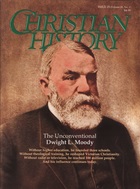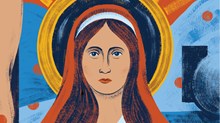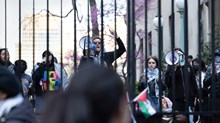For Dwight L. Moody the main task in life was evangelism, to “win men to Christ,” to save souls.
The salvation message, then, must be delivered as persuasively and as clearly as possible, and by as many evangelists as could be summoned for the task. Moody conceived of education as the means to prepare religious workers—first by converting them and then by training them to evangelize others. Not only seminary-trained pastors with B.D.’s were to be enlisted for the effort, but also legions of devoted laypersons who had received a brief but effective training. Since in Moody’s mind education and evangelism were so closely connected, most of his notions about education derived from his conception of the evangelistic task.
Moody’s Own Education
Moody himself had received only the most rudimentary education—about the equivalent of the fifth grade. In an era when most people did not attend high school, this was not remarkable, except that the lack of learning and polish showed all over Moody. During his early days in Chicago his grammar was impossible; his pronunciation smacked of the Massachusetts hill country of his boyhood; his vocabulary was poor; and his spelling can be described only as imaginative. His physical appearance struck even the street Arabs of Chicago as “uncouth.” He moved awkwardly, spoke awkwardly, and stumbled when he read. In short, Moody was not only ill educated; he also struck observers as a country bumpkin, a rube in the big city. An early Chicago acquaintance recalled, “No one ever thought he would amount to much on account of that fact that he was so poorly educated.”
Eventually Moody’s more polished and better educated wife, Emma Revell, gently went to work on him. Reportedly they spent an hour every day studying to make up Moody’s deficit. As a result, the evangelist became more presentable, though his grammar, spelling, and pronunciation always remained rough and uncertain.
He never became a student, never a real reader. He was too restless, too constantly intent on action. Theology never greatly interested him, nor did literature. The details of contemporary events the frequent labor troubles, the radical political movements, American involvement abroad failed to capture his attention. The clash of ideas did not stimulate him; mostly he surrounded himself with workers who agreed with him. He remained immune to theorizing, systematizing, and the codification of ideas; one gets the feeling that he regarded theorizers tolerantly as somewhat curious and quaint creatures. One book truly captivated his attention: the English Bible. An acquaintance recalled the Moody library as crowded not with works of theology or literary classics but with Bibles and biblical commentaries and interpretations. Even in this respect, Moody was far from a scholar. He was oblivious to the higher critical theories then achieving currency in the United States. Nor did he care about studying the Bible in its original languages.
In fact, Moody regarded the Bible as remarkably unproblematic, uncomplicated; it was self-interpreting if only one approached it in the proper spirit. Problems of consistency and obscurity of meaning that worried conservatives and liberals alike gave him hardly a moment’s pause. For Moody the Bible was a sort of commonplace book, a source of compelling stories and quotations, any of which was capable of going unaided directly to the human heart. Bible study need not even be very systematic. One of the women in Moody’s Chicago church recalled that after one Sunday meal, Mr. Moody said, “ ‘Now we’ll have honey out of the rock.’ He would go around the table calling on each one for a thought from the Bible.”
Other books, though less rich and certainly less inspired than the Bible, were useful in some of the same ways: to be combed for lively anecdotes and timely quotations. He once hired a woman student at Northfield School to mark passages in books “you haven’t heard me use” to be employed as illustrations for his sermons and addresses.
Inclusive Educational Ideas
Moody was not greatly interested in complex questions of pedagogy, despite the fact that his was an age of educational experimentation and theory: the ideas of the European educators Herbart, Pestalozzi, and Froebel permeated the air, and the American progressive educators like John Dewey were beginning their work. Educational leaders debated how best to connect education to real life, how to motivate students, and how to gear the content of learning to student understanding. Moody was smart and attuned enough to current educational ideas to pull them from the atmosphere, and perhaps in addition he had a natural instinct for the pedagogically sound approach; for instance, he vigorously preached the coordination of classroom knowledge with actual experience. An early Moody Bible Institute prospectus asserted, “Study and work go hand in hand.” And discipline in Moody’s Sunday schools came more from keeping students interested than from threatening them with a whipping. On the other hand, the question of motivation remained a simple matter to him, not a weighty pedagogical consideration. Persuading students to attend his Sunday school in Chicago involved unsubtle promises of “missionary sugar,” picnics, and pony rides, and the fun of roughhousing with Moody himself.
The evangelist also strongly believed in providing more educational opportunity for those who, like himself, had been deprived. Quite clearly Moody regarded his lack of education as a handicap, and yet he had demonstrated that a smart, earnest, and energetic young man, no matter how poor and uneducated, could prove astonishingly effective in religious work. He had also absorbed the egalitarian thinking common in America—“he was just as cordial with the humblest as with the highest,” an early acquaintance observed. And he was firmly convinced that those who had grown up in poverty were the best—equipped once they had received training—to proselytize among the poor, to stand as “gap men,” in his famous phrase, between the well-educated religious leaders and the masses.
Among the groups normally excluded from schooling, those without economic means found a welcome in Moody’s educational institutions. Neither the Northfield schools nor Moody Bible Institute charged tuition. The Northfield schools were intended for poor mountain kids, the Institute for students who had to work their way through school.
The evangelist was also well aware that girls and women had frequently been barred from educational institutions. The first of the Northfield schools was for girls; the school for boys came later. The early program he began in the 1870s with Emma Dryer that predated his Bible Institute involved only the training of women—not men—as evangelists. Moody initially assumed that the seminaries could take care of the men.
Finally, not even the disruptive and ill-behaved were excluded from Moody’s Chicago Sunday school—it was against school policy to evict any student, no matter how unruly.
The habit of inclusiveness was so firmly established at Moody Bible Institute that when, early in the twentieth century, Dean James M. Gray tried to limit admission to high school graduates, a barrage of opposition forced him to back down. Visiting instructors at the Institute were often nonplused at the wildly disparate educational backgrounds of early Institute students, all collected indiscriminately into the same classes.
Moody’s philosophy of inclusiveness educating the largest possible number whatever economic, educational, and geographical disabilities might limit them—unquestionably led to many of the Institute’s educational activities: the evening, extension, and correspondence classes; the Christian Workers Magazine published by MBI; and the Institute-sponsored Bible conferences. Moody himself organized the Bible Institute Colportage Association, which made possible the energetic distribution of inexpensive religious books. No doubt this same inclusive spirit, continued after Moody’s death, was responsible for the important role MBI played in evangelical broadcasting (with radio station WMBI) and in the production of religious films.
Institution Builder
If Moody was not an educational theorizer or systematizer, he certainly was an institution builder: Sunday school, conferences for Sunday school teachers, the Moody Church, the Chicago YMCA, the Northfield Conferences, and of course MBI and the Northfield schools. None of these institutional forms originated with him. Not even the Bible institute, novel at the time, was his brainchild, though Moody, like other early American founders of Bible schools and missionary training schools, had the sense to look to Europe and Great Britain for inspiration. Moody had actively studied certain well-known English institutions: the deaconess institute at Mildmay, Charles Spurgeon’s London college for poor and ill-educated Baptist pastors, George Muller’s orphanage-school at Bristol, and H. Grattan Guinness’s East London Institute for Home and Foreign Missions. The educational philosophy behind these institutions strongly appealed to Moody: they aimed to train those who otherwise would have lacked preparation for religious work; they sought out the very ones who would be most likely to evangelize among the poorer classes not ordinarily reached by pastors and evangelists. These institutions spurned the classical education in Greek and Latin current at the time in favor of concentraton on the English Bible and methods of Christian work. They set out to turn out efficient workers in the shortest possible time, teaching them only what they needed to know in order to become effective and consecrated workers.
Moody Bible Institute was formally constituted in 1889. At that time it was called the Institute for Home and Foreign Missions; though it took Moody’s name only later, from the beginning people tended to refer to it informally as “Moody’s.” It followed a couple of similar schools: the Baptist Missionary Training School for women in Chicago (1881) and the Missionary Training College in New York City (1882). The course at MBI was open to all no matter what their educational background—religious zeal counted for more—and lasted two years, though students could stay for shorter periods as they found necessary. Mostly students studied the English Bible, and they spent much of their time in Christian work—visiting homes, handing out tracts, conducting street meetings, teaching Sunday schools, and preaching in churches, prisons, and missions. Institute education was thoroughly biblical and practical.
A Typical Day
It is possible to catch a glimpse of a typical day at Moody Bible Institute in 1900. According to Bernard R. DeRemer, in Moody Bible Institute: A Pictorial History (Chicago: Moody Press, 1960), students awoke to the rising bell at 6:45 and went to breakfast and devotions at 7:30. Except for Sundays and Mondays (Mondays were set aside for rest and recreation), they attended classes each morning and additional classes in the early afternoon. Each day at 5:00 they went to Physical Culture (apparently tennis was a favorite activity). In classes, of course, they concentrated on the Bible, taking subjects such as chapter summary, Bible doctrine (three times a week), and analysis of Romans; they also studied religious music and methods of evangelism and of teaching the Bible. On Tuesday nights they had Synthetic Bible Study, a class most probably open to the public as well as to regular students. Students were expected to study about twelve hours a week. On top of that, they fulfilled several practical work appointments a week, and at “report hour” every Tuesday morning they discussed the results of their practical work and received advice from the faculty. Regular times were set aside for prayer and worship: Saturday evenings, Sunday mornings before church services, and the first Tuesday morning of every month. On Friday mornings students met for the “Missionary Study and Prayer Union,” at which they studied the needs of the various foreign missionary fields, prayed for missions, and heard missionaries on furlough. Each day students were expected to perform one hour of domestic work around the Institute. And of course those who were short of funds—a substantial number—held remunerative jobs outside the school. Life was often hectic.
As was the case in the other institutions he set up, Moody seldom involved himself in the day-to-day affairs of Moody Bible Institute. Others—Reuben A. Torrey and later James M. Gray—oversaw daily matters and of course set their own educational imprints upon the emerging school. Moody raised funds for it and dropped in from time to time, staying in the men’s dormitory and holding discussions with the students. A student in the Institute in 1897 recalled Moody’s breakfast talks:
They were like a father’s instructions to his son. Here he told us about those little things that so effect [sic] one’s ministry. Dress, mannerisms, length of sermons, etc., were all dealt with.… He often asked at these breakfast talks that the students give their best thoughts of the day before. When an especially good one was given he would comment on it.
Moody Bible Institute would continue long after its founder’s death to educate and evangelize widely. By the late 1920s it would enroll 1,000 students in each of its day and evening programs. Today, its day enrollment numbers 1,500, while extension and correspondence courses attract another 12,000 students.
When Everyone Needed Training
Dwight Moody, then, was a popular educator par excellence. His educational institutions encouraged all to attend. MBI especially reached out beyond its Chicago confines through correspondence, conferences, extension, publications, and broadcasting. Moody’s primary educational text—the Bible—was, he thought, thoroughly comprehensible to all who approached it with a good heart. He did not aim to train pastors with B.D.’s but rather laypersons (as he himself was a layperson)—including women. He had few formal educational theories about how to reach the greatest numbers of people with the message of salvation; instinctively, it seems, he did what worked and was aided in the process by a personality most people found charming and irresistible. In 1860, for example, Moody’s huge Sunday school (numbering as many as five hundred to six hundred students) attracted so much attention that Abraham Lincoln visited it during a trip to Chicago.
The late nineteenth century celebrated popular education and popular educators. The reasons for this enthusiasm were numerous: the educational needs of a rapidly industrializing nation; a renewed romance with the notion of democracy, in which all ought equally to receive enlightenment; and concern for Americanizing the thousands of new immigrants. As the turn of the century approached, more and more young people attended high schools, including the new manual training institutions. The first universities were just emerging, and they offered education not only for the elite, but also for the broader public: extension courses, popular Journals, summer schools and institutions evening schools, and learning by mail. Everyone, it seemed, needed training, and there were new schools started for salespeople, nurses, teachers, and engineers, among others. Even younger children were drawn in with the appearance of the German innovation of kindergarten. Religious leaders like Moody ardently joined the popular education efforts, fostering a religious education movement: the Chautauquas, Bible study conferences and classes, the International Sunday School Lessons, and of course the Bible institutes.
What precisely was the place of Moody in his era’s intense enthusiasm for popular education? Certainly he did not originate the attitudes nor the institutional forms. But as the foremost embodiment of “ordinary man,” and as inspired evangelist, fund raiser, publicist, institution builder, and salesman extraordinaire, he did as much as anyone to spread the gospel of popular education, especially popular religious education.
Dr. Virginia Lieson Brereton teaches history and writing at Harvard College. Her most recent book is The Formation of American Bible Schools, 1880–1940, A History (Indiana University Press, 1990).
Copyright © 1990 by the author or Christianity Today/Christian History magazine.
Click here for reprint information on Christian History.

Support Our Work
Subscribe to CT for less than $4.25/month






























